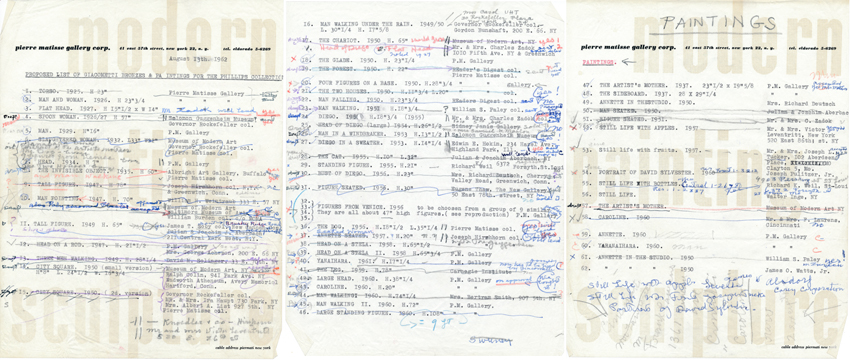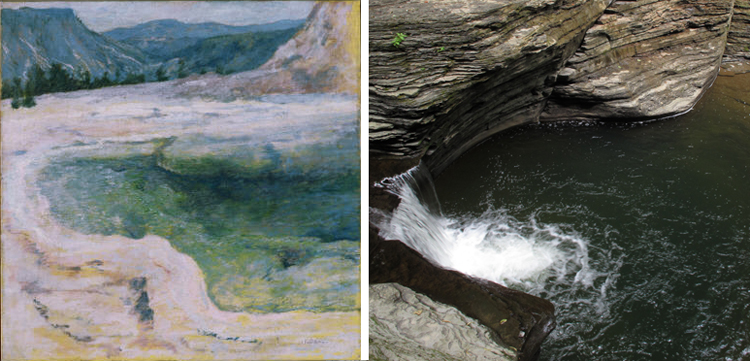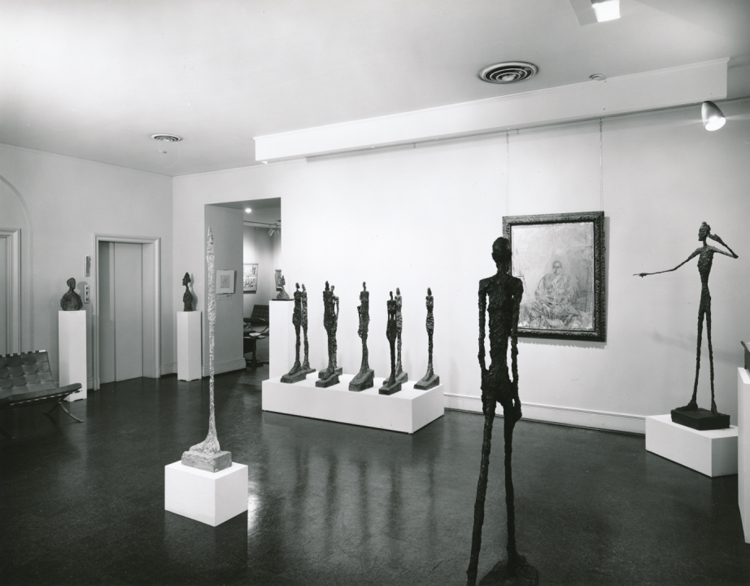On vacation last week in Upstate New York, I climbed the gorge at Watkins Glen State Park, spotting many pools that brought to mind John Twachtman’s The Emerald Pool (ca. 1895). Of course, Twachtman’s pool was likely a hot spring and surrounded by the open and dry dirt ground of Yellowstone Park and not the dark, wet stone and lush greenery of the glen. But the beautiful emerald effect of deep pooling water immediately brought this painting to my mind. Duncan Phillips was a great admirer of Twachtman, hanging The Emerald Pool in an esteemed spot alongside Monet for many years. And Marjorie Phillips recorded in her book that, after a visit to the Phillips in 1926, Pierre Bonnard said that it was his favorite American painting.
Author Archives: Sarah Osborne Bender
Giacometti at the Phillips, 1963
Vesna Pavlović’s Intersections work, Illuminated Archive (on view through September 28th), uses imagery from our 1963 exhibition Giacometti. That exhibition was years in the making and required many loans of large sculptural pieces which can be difficult to manage. Planned while Duncan Phillips was in his late 70s, his wife Marjorie played an active role in the securing of loans, writing many letters to museums as well as prominent collectors such as William and Babe Paley and Joseph Pulitzer, Jr. Assisting with locating works in both public and private collections, the Pierre Matisse Gallery provided Marjorie Phillips with the lists below, which were thoroughly annotated as the exhibition planning proceeded.

Works by Alberto Giacometti in public and private collections as listed by Pierre Matisse Gallery for The Phillips Collection. The Phillips Collection Archives, Washington, DC.
The result was a beautiful and popular show. The Phillipses remarked that they were so pleased, they wished it could remain as a permanent part of the museum.
“Look on the model with respect…”

Matisse on models: “I depend entirely on my model, who I observe at liberty, and then I decide on the pose which best suits her nature…. And then I become a slave of that pose.” Henri Matisse, Untitled (Seated Nude), ca. 1908. Ink on paper, 10 5/8 x 8 1/4 in. Gift of Marjorie Phillips, 1984. The Phillips Collection, Washington, DC.
Proving that no occupation is un-strikeable, nude models in France are threatening a strike for better wages and job benefits. Despite the many languid figurative works that may imply that nude modeling is nothing more than draping one’s body over a chaise, even those sessions can be plenty challenging. John Sloan, in his treatise Gist of Art (1939), offers this insight into the artist/model exchange:
The important thing to bear in mind while drawing the figure is that the model is a human being, that it is alive, that it exists there on the stand. Look on the model with respect, appreciate his or her humanity. Be very humble before that human being. Be filled with wonder at its reality and life. There is a human creature that lives and breathes and feels, a thing with a mind and character of its own—not a patchwork of light and shadow, color shapes.
Sometimes when I come into the classroom I look at the model and see that she is shivering with cold or suffering in some difficult post she is trying to hold too long. You look up at her and back at the paper, tick-tock, back and forth—all you are looking for is some detail of the appearance of the figure.



